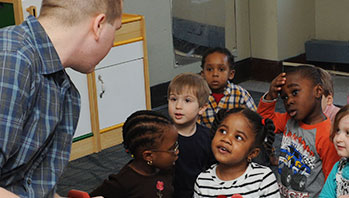- chart paper
- marker
- pictures of plants (flowers, trees, bushes, grass, etc.)
- seeds
- environment
- plant
MA Standards:
Speaking and Listening/SL.PK.MA.1: Participate in collaborative conversations with diverse partners during daily routines and play.
Language/L.PK.MA.1: Demonstrate use of oral language in informal everyday activities.
Language/L.PK.MA.6: Use words and phrases acquired through conversations, listening to books read aloud, activities, and play.
Head Start Outcomes
Language Development/Receptive Language: Attends to language during conversations, songs, stories, or other learning experiences.
Language Development/Expressive Language: Uses language to express ideas and needs.
PreK Learning Guidelines:
English Language Arts/Language 2: Participate actively in discussions, listen to the ideas of others, and ask and answer relevant questions.
Talk Together: Introduce Plants

© Commonwealth of Massachusetts, Department of Early Education and Care (Jennifer Waddell photographer). All rights reserved.
STEM Key Concepts: There are many different types of plants and seeds; Some plants start from seeds; Some plants start from bulbs; Plants grow in many places; Plants need water, food, and sunlight to grow; Plants grow in places where they get their needs met; Plants often grow in some type of dirt
ELA Focus Skills: Speaking and Listening, Vocabulary
Educator Prep: Before gathering children designate an area on the wall as the “Plant Wall” where you can hang photos, drawings, and recordings children make throughout the unit. At the top of the area place the label “Plant Wall.” Display pictures or photos on the wall to reference while introducing the topic of plants to children.
Tell children that they will be learning about and exploring different types of plants. Explain to children that they will be learning about the different kinds of plants that grow in their local environment, or the area they live in.
Draw children’s attention to the “Plant Wall” and focus on the pictures of different kinds of plants (grass, flowers, trees, shrubs, etc.). Tell children they will go outside today to explore plants. Write “Plants All Around” on a sheet of chart paper and have children add new ideas they learn about plants throughout the unit.
Ask children,
- Do you think plants are living things? Why or why not?
- How do you think plants are like other living things?
Over the course of the next few weeks you will help children begin to understand that plants, like all living things:
- Have characteristics that can be observed and described
- Have parts that help them survive
- Have specific needs for food, water, and some amount of sunlight
- Have life cycles (are produced, grow, reproduce themselves, and die)
- Exhibit diversity (there are many different types) and variation (even individuals of the same type show differences)
- Are dependent on the environment to get their needs met
- Are interdependent with other living things
English Language Learners: Help children grasp the meaning of the word environment by showing pictures of the local area, pictures of their native environment, and pictures of other different environments (e.g., seashore, mountains, desert, forest, city, country). Say, There are many different kinds of environments. An environment is the area in which something lives. Give an example by asking children what they observe in the environment of the classroom. Remember to use this word during your explorations with children.
